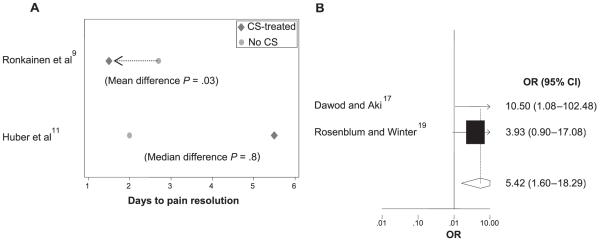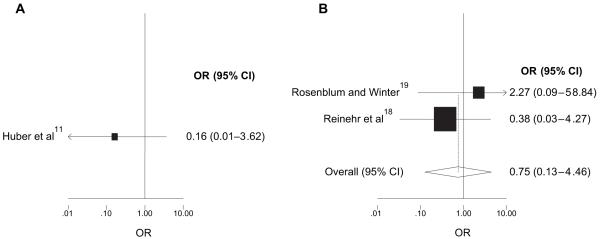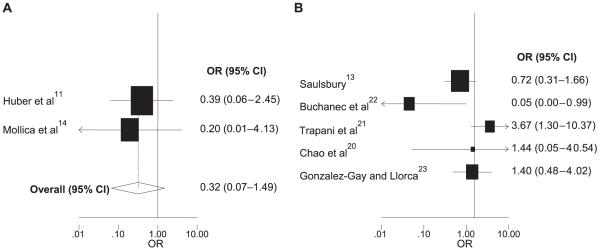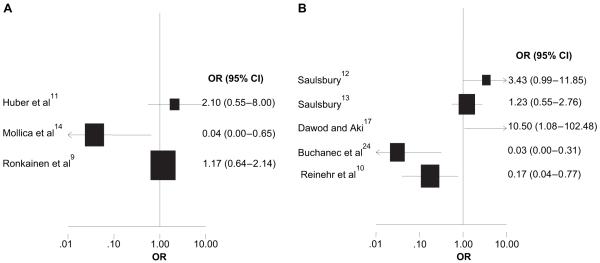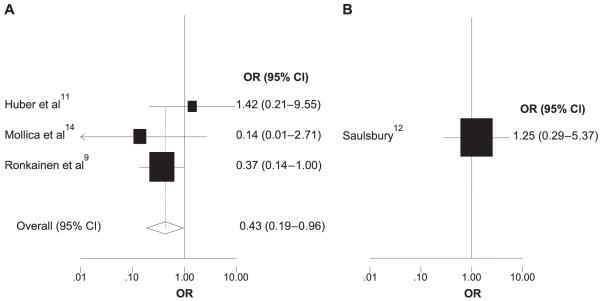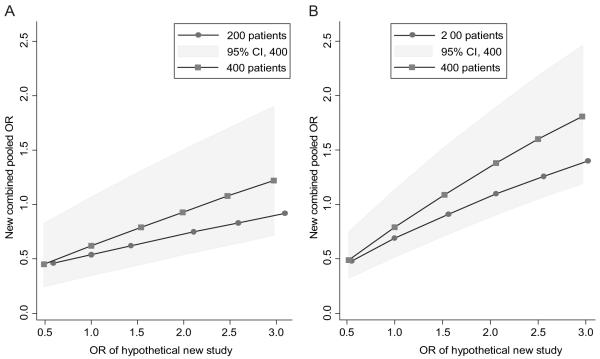Abstract
OBJECTIVE
No consensus exists among general pediatricians or pediatric rheumatologists regarding whether corticosteroid therapy ameliorates the acute manifestations of Henoch-Schönlein purpura or mitigates renal injury. Therefore, we sought to synthesize the reported experimental and observational data regarding corticosteroid use.
METHODS
We performed a meta-analysis based on a comprehensive review of the literature in the Medline database (1956 to January 2007) and the Cochrane Controlled Trials Register. On the basis of reported outcomes among patients with Henoch-Schönlein purpura who were treated at diagnosis with corticosteroids compared with patients treated with supportive care only, we calculated odds ratios for the resolution of abdominal pain, the need for surgical intervention secondary to severe pain or intussusception, the likelihood of Henoch-Schönlein purpura recurrence, and the development of transient or persistent renal disease.
RESULTS
Of 201 articles retrieved from the initial literature search, 15 were eligible for inclusion. Corticosteroid treatment did not reduce the median time to resolution of abdominal pain but did significantly reduce the mean resolution time and increased the odds of resolution within 24 hours. Early corticosteroid treatment significantly reduced the odds of developing persistent renal disease. In addition, although the results were not statistically significant, the prospective data suggest reduced odds of both surgical intervention and recurrence.
CONCLUSIONS
Corticosteroids, given early in the course of illness, seem to produce consistent benefits for several major clinically relevant Henoch-Schönlein purpura outcomes.
Keywords: Henoch-Schönlein purpura, corticosteroids, children, meta-analytic methods, systematic reviews
Henoch-schönlein purpura (hsp) is the most common vasculitis of childhood, affecting between 8 and 20 per 100 000 children annually and accounting for 49% of all childhood vasculitides in the United States.1,2 Although typically self-limited, HSP can cause gastrointestinal hemorrhage, intussusception, and end-stage renal disease (ESRD). Renal involvement, manifested by hematuria, proteinuria, nephrotic syndrome, or renal insufficiency, may occur in 60% of children.3 In 1 recent study, 54% of patients developed renal manifestations within 3 months of diagnosis, 11.6% had persistent abnormalities after 7 years, and none developed ESRD.4 However, previous studies have reported that as much as 21% of children with HSP-associated nephritis develop rapidly progressive glomerulonephritis5; 15% of these children with HSP-associated rapidly progressive glomerulonephritis, which is to say 2% of all patients with HSP, may progress to have uremia or ESRD.6 Furthermore, even seemingly benign HSP may have long-lasting effects: 2 studies have reported that 40% and 70% of term pregnancies of women with a history of childhood-onset HSP were complicated by hypertension, proteinuria, or preeclampsia.7,8
The goals of treating HSP are typically to (1) ameliorate acute symptoms, (2) mitigate short-term morbidity (such as abdominal complications that require surgery), and (3) prevent chronic renal insufficiency. Because HSP is characterized by leukocyte infiltration of the blood vessel walls along with immunoglobulin A deposition (with resulting vascular injury and necrosis), and because corticosteroids inhibit inflammatory processes, early treatment with corticosteroids has been postulated to be effective for all 3 therapeutic goals, but much controversy remains.9-13 Although the literature is replete with retrospective studies that evaluated corticosteroid use for HSP, currently there are only 3 published prospective, placebo-controlled studies on the subject, and they vary in their conclusions regarding the utility of early corticosteroid administration.9,11,14
Through a systematic review and meta-analysis, we sought to compare and contrast the experimental and observational data regarding corticosteroid use and, where appropriate, synthesize the data for 5 main clinical questions: (1) Do corticosteroids shorten the duration of abdominal symptoms in HSP? (2) Do corticosteroids decrease the odds of surgical intervention for HSP? (3) Do corticosteroids decrease the odds of disease recurrence? (4) Do corticosteroids decrease the odds of renal disease (transient plus persistent) in HSP? and (5) Do corticosteroids decrease the odds of developing persistent renal disease in HSP?
METHODS
Data Sources
The published medical literature was searched by using the Cochrane Controlled Trials Register (CCTR) and Medline database. Articles written in all languages were included in the search, and translation was obtained when needed.
CCTR and Medline were searched by using the Medical Subject Headings (MeSH) terms “steroids,” “methylprednisolone,” and “dexamethasone” and the key words “Henoch” and “corticosteroids.” “Henoch” and “purpura, Schönlein-Henoch” were grouped together and joined by “or.” “Steroids,” “methylprednisolone,” “dexamethasone,” and “corticosteroids” were grouped together and joined by “or.” Both groups of terms were joined together by “and.” The only limit applied to the search was “all children: 0-18 years.”
Given the large number of studies obtained from the literature search (N = 201), we cite in this report only the studies that were chosen for inclusion. A full list of publications is available at www.pediatric-generalists.org/weiss.htm.
Study Eligibility
Eligible studies were limited to those that examined the use of corticosteroids for the treatment of HSP; observational and randomized, controlled trials were included. An article was excluded if it (1) was a review, (2) examined therapy with a drug other than corticosteroids, (3) was a case report with fewer than 5 subjects with HSP, (4) focused on individuals older than 18 years, (5) did not discuss therapy with corticosteroids, (6) included only patients with nephritis at study onset, (7) did not assess definite outcomes, or (8) did not discuss HSP.
Study Selection
The initial literature search of the CCTR and Medline databases yielded 201 articles in 14 languages. Titles were reviewed to screen for eligibility. If the title yielded insufficient data to determine if a study was eligible, the abstract was obtained and reviewed. Articles without sufficient information in the abstract or those without an accessible abstract were examined in full text. Interpreters who were familiar with medical language and study designs evaluated all articles written in languages other than English.
Two of the authors (Drs Weiss and Feinstein) independently screened each of the potential titles, abstracts, and articles to determine inclusion. Disagreements were resolved by discussion and consensus mediated by a third author (Dr Feudtner). Reasons for article exclusion are presented in Table 1. After all the exclusions were applied, 15 articles remained for further analysis (Table 2).
TABLE 1. Reasons for Exclusion of Articles.
| n | |
|---|---|
| Initial set: total | 201 |
| Excluded: totala | 186 |
| Review articles2,29–57 | 30 |
| Case reports with <5 cases3,58–113 | 79 |
| Therapy with drug(s) other than corticosteroids114–184 | 54 |
| Focus on patients >18 y old185–189 | 4 |
| No corticosteroid therapy190 | 1 |
| Nephritis at onset in all patients5,191–200 | 11 |
| No extractable outcomes201–206 | 6 |
| Not an HSP study207 | 1 |
| Final set: total | 15 |
The references cited (29–207) are available at www.pediatric-generalists.org/Weiss/All-Citations-for-HSP-Systematic-Review.pdf .
TABLE 2. Summary of Included Articles and Corticosteroid Use.
| Author | Sample Size |
Study Design | Corticosteroid Dose |
Initiation of Treatment From Time ofDiagnosis |
|
|---|---|---|---|---|---|
| Dose, mg/kg per d |
Duration | ||||
| Ronkainen etal9(2006) | 171 | Prospective, randomized, placebo-controlled |
1 | 2 wk, weaning over 2 wk | At diagnosis |
| Huberetal11 (2004) | 40 | Prospective, randomized, placebo-controlled |
2 | 1 wk, weaning over 1 wk | At diagnosis |
| Mollica etal14 (1992) | 168 | Prospective, randomized, placebo-controlled |
1 | 2 wk | At diagnosis |
| Trapani etal21 (2005) | 150 | Retrospective | 1–2 | Mean of 13.7 d (range: 7–32) | Not stated |
| Gonzalez-Gay and Llorca23 (2005) | 78 | Retrospective | Not stated | Not stated | |
| Reinehr etal18 (2000) | 101 | Retrospective | 2a | 1wk | <3 wk (46%), >3 wk (54%) |
| Reinehr etal10 (2000) | 171 | Retrospective | 2a | 1wk | <3 wk(15%), >3wk(85%) |
| Chao et al20(2000) | 20 | Retrospective | Not stated | Range: 3–7 d | Not stated |
| Saulsbury13 (1999) | 100 | Retrospective | 1.6b | Mean: 8.9 d (range: 5–28 d) | Mean: 8.5 d (range: 1–40 d) |
| Temmel etal16 (1993) | 86 | Retrospective | 2 | 1 wk, weaning over 1 wk | At diagnosis (30%), at onset of abdominal pain (70%) |
| Saulsbury12 (1993) | 69 | Retrospective | 1.7c | Mean: 8 d (range: 5–10 d) | Mean: 5 d (range: 1–19 d) |
| Dawodand Akl17 (1990) | 40 | Retrospective | 1–2 | Mean: 7 d (range: 3–30 d) | Not stated |
| Buchanec etal22 (1988) | 39 | Retrospective | 1–2.5 | 10 d, weaning over 1–2 wk | At diagnosis |
| Buchanec etal15 (1987) | 33 | Retrospective | 1–2.5 | 10 d, weaning over 1–2 wk | At diagnosis |
| Rosenblum and Winter19 (1987) | 43 | Retrospective | 1–2 | Not stated | <1 wk(75%), < 12 d (96%) |
Shown is a summary of the 15 included articles’ study design, corticosteroid dose, duration of treatment, and timing of treatment in respect to diagnosis.
Dose was increased to 3 to 5 mg/kg per day if abdominalpain was present for >24 hours.
Mean dose: 1.6 mg/kg per day (range: 1.2–2.0 mg/kg per day).
Mean dose: 1.7 mg/kg per day (range: 1.3–2.1 mg/kg per day).
In an attempt to find all relevant articles, the reference lists of included articles were searched and yielded 2 additional articles for potential inclusion.15,16 However, neither article was included because the outcomes could not be abstracted. In addition, the authors of the included articles were contacted to learn of any unpublished trials or studies.
Data Extraction
Two authors (Drs Weiss and Feinstein) independently abstracted data from the remaining articles. Disagreements were resolved by discussion and consensus mediated by a third author (Dr Feudtner). Abstracted data from the remaining articles included information regarding the study population, existence of a control group, study limitations, and information relating to the resolution of abdominal pain, surgical intervention, recurrence, and the incidence of renal sequelae.
Statistical Analyses
Pooled odds ratios (ORs) were obtained by using the “metan” command for Stata 9.2 (Stata Corp, College Station, TX) for each of 5 clinical outcomes: (1) resolution of abdominal pain; (2) surgical intervention for severe abdominal pain or intussusception; (3) recurrence; (4) cumulative renal abnormalities; and (5) persistent renal abnormalities. The odds of having each outcome in patients who were treated with corticosteroids was compared with patients treated with routine supportive care for both prospective and retrospective studies. Results from fixed-effects models are reported. Tests for heterogeneity were performed for each analysis as a way to evaluate to what extent the results were consistent and suitable for fixed-effect modeling. If the test for heterogeneity was significant, we did not calculate a pooled OR. The Egger test for bias was performed and funnel plots were performed for each of the clinical outcomes to evaluate for publication bias. Each of the funnel plots was symmetrical, which suggests the absence of publication bias. The Egger test for bias could only be applied to analyses with 2 or more studies.
RESULTS
Do Corticosteroids Shorten the Duration of Abdominal Symptoms in HSP?
Although there is no consensus regarding the indication for corticosteroid use in HSP, anecdotally, abdominal pain is the most common reason that corticosteroids are prescribed. Huber et al11 and Ronkainen et al9 prospectively evaluated the effect of corticosteroids on abdominal pain duration by using 14-day symptom diaries. Huber et al11 used 2 mg/kg per day of corticosteroids for 1 week, with weaning over week 2, whereas Ronkainen et al9 used 1 mg/kg per day of corticosteroids for 2 weeks, with weaning over weeks 3 and 4 (Table 2). Using median values of total abdominal pain duration, Huber et al did not find any difference between the treatment and control groups (P = .8) (Fig 1A). In contrast, Ronkainen et al found a mean reduction of 1.2 days of pain in patients who were treated with corticosteroids (P = .03) (Fig 1A). Three retrospective studies reported on such effects within the first 24 hours after corticosteroid administration.17-19 However, after analysis, there was evidence of heterogeneity among the included studies (P = .015). A likely source of heterogeneity was the timing of corticosteroid administration in relation to disease onset. In the study by Reinehr et al18 31 of 57 patients received corticosteroids >21 days after the onset of HSP, whereas in the other 2 studies the treatment group received corticosteroids within several days of diagnosis. Analysis excluding the study by Reinehr et al showed a statistically significant positive corticosteroid effect, and there was no significant heterogeneity (OR: 5.42; 95% confidence interval [CI]: 1.60–18.29; P = .476) (Fig 1B).
FIGURE 1.
Corticosteroid (CS) treatment of HSP and resolution of abdominal pain. A, Prospective: time to resolution of abdominal pain (days) reported in means and medians. B, Retrospective: ORs (95% CIs) of abdominal pain resolution within 24 hours of corticosteroid administration. The box size is proportional to the inverse of the magnitude of the variance.
A study by Chao et al20 looked at a unique group of patients with HSP who had hepatobiliary involvement. Involvement was defined by elevated liver transaminase levels and abnormal abdominal ultrasound results. Of those treated with corticosteroids, 90% with hepatic involvement, 100% with cholecystitis, and 100% with gallbladder sludge recovered within 7 days. In contrast, in the untreated group, 25% with hepatic involvement, none of those with cholecystitis, and only 50% with gallbladder sludge had resolution within 7 days. All patients in both groups, however, had resolution of symptoms by 14 days.
Do Corticosteroids Decrease the Incidence of Surgical Intervention for HSP?
Only 3 studies (1 randomized, controlled trial and 2 observational trials) reported intussusception, a rare and potentially life-threatening abdominal complication during the acute phase of HSP.11,18,19 Huber et al11 provided the only prospective study that reported incidence of intussusception; the risk of intussusception was reduced, but not to a significant degree, in the group that received corticosteroids (OR: 0.16; 95% CI: 0.01–3.62). The 2 retrospective studies together suggest a protective effect of corticosteroid exposure (OR: 0.75; 95% CI: 0.13–4.46) (Fig 2). There was no evidence of heterogeneity between the studies (P = .39).
FIGURE 2.
Corticosteroid treatment and odds of surgery. Shown are the ORs (95% CIs) of subsequent surgical intervention for severe abdominal pain and/or intussusception. A, Prospective; B, retrospective. The box size in B is proportional to the inverse of the magnitude of the variance.
Does Early Treatment With Corticosteroids Decrease the Odds of HSP Recurrence?
Recurrences affect up to one third of children with HSP.13,21 Many of these children require additional hospital admissions and pharmacotherapy. The 2 prospective studies with recurrence data suggest a protective effect of corticosteroids (OR: 0.32; 95% CI: 0.07–1.49), and there was no significant heterogeneity (P = .70) (Fig 3).11,14 The 5 retrospective observational studies that examined HSP recurrence exhibited heterogeneity (P < .01), so a pooled OR is not reported.11,13,14,20-23 The ORs and 95% CIs are reported for each study (Fig 3). No evidence of publication bias was found (Egger test: P = .55).
FIGURE 3.
Corticosteroid treatment of HSP and odds of recurrence. Shown are the ORs (95% CIs) of HSP recurrence. A, Prospective; B, retrospective. The box sizes are proportional to the inverse of the magnitude of the variance. No overall OR is displayed in B because of the heterogeneity of the studies.
Do Corticosteroids Decrease the Likelihood of Developing Cumulative Renal Abnormalities With HSP?
Eight studies have reported data on cumulative (transient or persistent) renal abnormalities during the year after diagnosis.9-14,17,24 Heterogeneity was present among both the prospective and retrospective studies (P = .03 and P < .01, respectively), so pooled ORs are not reported. Instead, the individual ORs and 95% CIs of each study, prospective and retrospective, are shown (Fig 4). No evidence of publication bias was found (Egger test: P = .59 and .66 for the prospective and retrospective studies, respectively).
FIGURE 4.
Corticosteroid treatment and odds of cumulative incidence of renal disease. Shown are the ORs (95% CIs) of patients with HSP with cumulative (transient or persistent) renal involvement if treated early with corticosteroids. A, Prospective; B, retrospective. The box sizes are proportional to the inverse of the magnitudeof the variance. No overall OR is displayed because of the heterogeneity of the studies.
Do Corticosteroids Decrease the Likelihood of Developing Persistent Renal Abnormalities?
In the 3 prospective studies, early corticosteroid treatment significantly reduced the odds of developing persistent renal disease (OR: 0.43; 95% CI: 0.19–0.96) (Fig 5A).8,10,13 There was no evidence of marked heterogeneity among the studies (P = .341). In addition, no evidence of publication bias was found (Egger test: P = .99). The retrospective study by Saulsbury12 did not show a statistically significant difference in renal outcome between the exposed and unexposed patients (OR: 1.25; 95% CI: 0.29–5.37) (Fig 5B).
FIGURE 5.
Corticosteroid treatment and odds of persistent renal disease. Shown are the ORs (95% CIs) of persistent renal involvement after HSP diagnosis. A, Prospective; B, retrospective. An end point of 1 year was used for the Huber et al11 and Mollica et al14 studies and 6 months for the Ronkainen et al9 study. The box size in A is proportional to the inverse of the magnitude of the variance.
Sensitivity Analyses
Does the Dose of Corticosteroid Matter?
We investigated if the corticosteroid dose affects the likelihood of developing persistent renal disease by using unrestricted and restricted regression models and the likelihood-ratio test. The doses and duration of treatment for each study are listed in Table 2. Two studies were excluded from this analysis because corticosteroid dose was not reported.20,23 The result of the likelihood-ratio test was statistically insignificant (P = .07), which suggests but fails to identify a significant dose-response effect.
What Future Study Would Reverse the Findings of This Meta-analysis?
Sensitivity analyses were performed to determine what sample size and magnitude of effect of a future hypothetical study would be required to reverse the findings, from the prospective studies, regarding the benefit of corticosteroid to decrease persistent renal disease presented in this meta-analysis. We conducted sensitivity analyses with hypothetical sample sizes of 200 and 400 patients and assuming an incidence of 5% and 20% persistent renal involvement in the control group (Fig 6). If the baseline risk of renal involvement in controls is 5%, a new study with 200 patients would need an effect size greater than an OR of 3.0 for the pooled OR to reach 1.0. A study with 400 patients would need an effect size greater than an OR of 2.25 for the new pooled OR to reach 1.0; for the new pooled OR to be statistically significant, the effect size would need to be larger than 3 (Fig 6A). If the baseline risk of renal involvement in controls is 20%, the OR of a new study with 200 patients would need to be >1.75 to raise the pooled OR to 1.0 and >3.0 to achieve significance. A new study with 400 patients would need an OR of >1.4 to raise the pooled OR to 1.0 and >2.25 to achieve statistical significance (Fig 6B).
FIGURE 6.
Sensitivity analysis of effect size of future hypothetical studies for likelihood of persistent renal involvement. Shown are the new combined pooled OR versus OR of a hypothetical new study with sample sizes of 200 and 400. The prevalence of persistent renal involvement in the control group was calculated at either 5% (A) or 20% (B).
DISCUSSION
This systematic review and data summary of 15 eligible articles suggests that early treatment of corticosteroids for children with HSP is associated with statistically significant increased odds of abdominal pain resolution within 24 hours and reduced odds of persistent renal disease. In addition, although the analyses lacked sufficient statistical precision, the likelihood of surgical intervention and of HSP recurrence may also be reduced. Overall, across all analyses, the pattern of effect is in the direction favoring the use of corticosteroids; none of the analyses indicated harm.
This review emphasizes the necessity for a more complete understanding of the ways in which corticosteroids impact the course of HSP, in both the acute and chronic settings. Corticosteroids were first postulated to benefit children with HSP in the 1950s and are effective in the treatment of other vasculitides in children and adults.25 Corticosteroids are the cornerstone of treatment for the majority of juvenile vasculitides including systemic lupus erythematosus, Wegener granulomatosis, polyarteritis nodosa, and Takayasu arteritis. By contrast, corticosteroid treatment is controversial for use for Kawasaki disease, another acute childhood vasculitis with potential morbidity and mortality; 1 recent report found no effect of corticosteroid,26 whereas others have heralded the beneficial effects of corticosteroids.27,28 Given this information should corticosteroid be given to children who present to the hospital with new-onset HSP? A rigorous answer to this question would have substantial clinical implications. Despite the widespread use of corticosteroids for vasculitides, there is no consensus yet among physicians as to whether corticosteroids should be given for HSP and, if so, for what indications.
There are several important potential limitations of the evidence we present. First, the definition of renal involvement differed among the studies, which means that different dimensions or degrees of HSP severity were potentially captured. For example, among the 3 prospective studies, the definition of proteinuria ranged from 200 to 400 mg/L, and the definition of hematuria ranged from 5 to 10 red blood cells per high-powered field. Second, the dosing regimens and mode of delivery for corticosteroids were not the same in each study (Table 2). When corticosteroid therapy was stratified by high- versus low-dose steroids for each of the clinical outcomes, there were no statistical differences between the 2 groups (data not shown). Although various doses of corticosteroids or the method of delivery (oral versus intravenous) may affect the size of the risk reduction, these changes in dose or route are unlikely to reverse the direction of effects. Third, the studies did not uniformly classify HSP cases as incident or recurrent. Therefore, the potential exists to inappropriately group severe recurrence with milder recurrence such as rash alone. Like-wise, given uncertainty about loss to follow-up, particularly in the corticosteroid-treated group, the protective effect of corticosteroids is likely to be an underestimate.
Two other limitations should be kept in mind when interpreting these data. First, our ability to draw robust conclusions was hampered by the limited number of prospective studies and small numbers of patients within the studies, which often resulted in imprecise measures of treatment effects. Although the effect of corticosteroid on several of the outcomes did achieve statistically significant evidence of benefit, the failure to demonstrate benefit regarding other outcomes and the failure to show a significant dose-response effect may reflect either the still relatively underpowered nature of the combined existing studies or a true absence of impact. Second, the effects noted in the retrospective observational studies probably include some degree of confounding by indication, whereby patients with greater disease severity were more likely to receive corticosteroids. Given that most of the retrospective studies nevertheless continued to show a benefit, the results across all studies are more reassuring.
These caveats not withstanding, our findings suggest that the potential benefit of corticosteroid administration early in the course of HSP may be more prominent than previously suggested for both acute (pain, surgical intervention) and chronic (recurrence, renal disease) complications of disease. If corticosteroid therapy is truly as effective as this meta-analysis suggests, then broader use of corticosteroid would likely decrease prolonged hospitalization, the risk of surgery, or chronic renal disease and may, by extension, prove beneficial even for those seemingly benign cases in female patients who later develop complications during pregnancy. As demonstrated by the sensitivity analyses, our findings regarding the potential benefit of corticosteroid to reduce chronic renal disease are robust; to reverse our findings, not only would the sample size need to be greater than any published study on HSP to date, but it also would have to show an OR of harm from corticosteroid administration >2.25, which is unlikely. Better-designed retrospective studies with standardization of corticosteroid exposure by accounting for the probability that any patient would receive corticosteroids and larger prospective, randomized, controlled trials are needed to assess all clinically relevant outcomes. Knowledge from such studies is essential for guiding our interventions early in the course of HSP and improving patient outcomes for both children and adults.
ACKNOWLEDGMENTS
Pamela Weiss is funded, in part, by a National Institutes of Health pharmacoepidemiology T32 training grant.
We thank Frank Pessler, Eric Hanson, Alba Hanson, Jan Boswinkel, Keri Cohn, Eva Lynch, Anna Genin, Kaoru Saijo, and Lorenza Frisoni for translation of abstracts and articles. We also thank David D. Sherry and James Guevara for critical reading of the manuscript.
Abbreviations
- HSP
Henoch-Schönlein purpura
- ESRD
end-stage renal disease
- CCTR
Cochrane Controlled Trials Register
- OR
odds ratio
- CI
confidence interval
Footnotes
The authors have indicated they have no financial relationships relevant to this article to disclose.
References
- 1.Bowyer S, Roettcher P, Pediatric rheumatology, Pediatric Rheumatology Database Research Group clinic populations in the United States: results of a 3 year survey. J Rheumatol. 1996;23:1968–1974. [PubMed] [Google Scholar]
- 2.Rostoker G. Schönlein-Henoch purpura in children and adults: diagnosis, pathophysiology and management. BioDrugs. 2001;15:99–138. doi: 10.2165/00063030-200115020-00004. [DOI] [PubMed] [Google Scholar]
- 3.Kobayashi O, Wada H, Okawa K, Takeyama I. Schönlein-Henoch’s syndrome in children. Contrib Nephrol. 1975;4:48–71. [PubMed] [Google Scholar]
- 4.Calviño MC, Llorca J, García-Porrúa C, Fernández-Iglesias JL, Rodriguez-Ledo P, González-Gay MA. Henoch-Schönlein purpura in children from northwestern Spain: a 20-year epidemiologic and clinical study. Medicine (Baltimore) 2001;80:279–290. doi: 10.1097/00005792-200109000-00001. [DOI] [PubMed] [Google Scholar]
- 5.Levy M, Broyer M, Arsan A, Levy-Bentolila D, Habib R. Anaphylactoid purpura nephritis in childhood: natural history and immunopathology. Adv Nephrol Necker Hosp. 1976;6:183–228. [PubMed] [Google Scholar]
- 6.Ronkainen J, Ala-Houhala M, Huttunen NP, et al. Outcome of Henoch-Schoenlein nephritis with nephrotic-range proteinuria. Clin Nephrol. 2003;60:80–84. doi: 10.5414/cnp60080. [DOI] [PubMed] [Google Scholar]
- 7.Ronkainen J, Nuutinen M, Koskimies O. The adult kidney 24 years after childhood Henoch-Schönlein purpura: a retrospective cohort study. Lancet. 2002;360:666–670. doi: 10.1016/S0140-6736(02)09835-5. [DOI] [PubMed] [Google Scholar]
- 8.Goldstein AR, White RH, Akuse R, Chantler C. Long-term follow-up of childhood Henoch-Schönlein nephritis. Lancet. 1992;339:280–282. doi: 10.1016/0140-6736(92)91341-5. [DOI] [PubMed] [Google Scholar]
- 9.Ronkainen J, Koskimies O, Ala-Houhala M, et al. Early prednisone therapy in Henoch-Schönlein purpura: a randomized, double-blind, placebo-controlled trial. J Pediatr. 2006;149:241–247. doi: 10.1016/j.jpeds.2006.03.024. [DOI] [PubMed] [Google Scholar]
- 10.Reinehr T, Burk G, Berger T, Doeker B, Andler W. Steroids for prophylaxis of nephropathy in Schnlein Henoch purpura? Follow-up of 171 patients [in German] Klin Padiatr. 2000;212:99–102. doi: 10.1055/s-2000-9660. [DOI] [PubMed] [Google Scholar]
- 11.Huber AM, King J, McLaine P, Klassen T, Pothos M, A randomized. placebo-controlled trial of prednisone in early Henoch Schönlein purpura [ISRCTN85109383] BMC Med. 2004;2:7. doi: 10.1186/1741-7015-2-7. [DOI] [PMC free article] [PubMed] [Google Scholar]
- 12.Saulsbury FT. Corticosteroid therapy does not prevent nephritis in Henoch-Schönlein purpura. Pediatr Nephrol. 1993;7:69–71. doi: 10.1007/BF00861574. [DOI] [PubMed] [Google Scholar]
- 13.Saulsbury FT. Henoch-Schönlein purpura in children: report of 100 patients and review of the literature. Medicine (Baltimore) 1999;78:395–409. doi: 10.1097/00005792-199911000-00005. [DOI] [PubMed] [Google Scholar]
- 14.Mollica F, Li Volti S, Garozzo R, Russo G. Effectiveness of early prednisone treatment in preventing the development of nephropathy in anaphylactoid purpura. Eur J Pediatr. 1992;151:140–144. doi: 10.1007/BF01958961. [DOI] [PubMed] [Google Scholar]
- 15.Buchanec J, Galanda V, Minarik M, Zibolen M. Can the nephropathy in Schonlein-Henoch purpura (syndrome) be prevented by early administration of steroids? Clin Nephrol. 1987;28:156. [PubMed] [Google Scholar]
- 16.Temmel AF, Emminger W, Schroth B, Zaunschirm HA, Gadner H. Early prednisone treatment and nephropathy in anaphylactoid purpura. Eur J Pediatr. 1993;152:782–783. doi: 10.1007/BF01954006. [DOI] [PubMed] [Google Scholar]
- 17.Dawod ST, Akl KF. Henoch-Schöenlein syndrome in Qatar: the effects of steroid therapy and paucity of renal involvement. Ann Trop Paediatr. 1990;10:279–284. doi: 10.1080/02724936.1990.11747443. [DOI] [PubMed] [Google Scholar]
- 18.Reinehr T, Burk G, Andler W. Does steroid treatment of abdominal pain prevent renal involvement in Henoch-Schönlein purpura? J Pediatr Gastroenterol Nutr. 2000;31:323–324. doi: 10.1097/00005176-200009000-00028. [DOI] [PubMed] [Google Scholar]
- 19.Rosenblum ND, Winter HS. Steroid effects on the course of abdominal pain in children with Henoch-Schonlein purpura. Pediatrics. 1987;79:1018–1021. [PubMed] [Google Scholar]
- 20.Chao HC, Kong MS, Lin SJ. Hepatobiliary involvement of Henoch-Schönlein purpura in children. Acta Paediatr Taiwan. 2000;41:63–68. [PubMed] [Google Scholar]
- 21.Trapani S, Micheli A, Grisolia F, et al. Henoch Schonlein purpura in childhood: epidemiological and clinical analysis of 150 cases over a 5-year period and review of literature. Semin Arthritis Rheum. 2005;35:143–153. doi: 10.1016/j.semarthrit.2005.08.007. [DOI] [PubMed] [Google Scholar]
- 22.Buchanec J, Galanda V, Beláková S, Minárik M, Zibolen M. Incidence of renal complications in Schönlein-Henoch purpura syndrome in dependence of an early administration of steroids. Int Urol Nephrol. 1988;20:409–412. doi: 10.1007/BF02549574. [DOI] [PubMed] [Google Scholar]
- 23.Gonzalez-Gay MA, Llorca J. Controversies on the use of corticosteroid therapy in children with Henoch-Schönlein purpura. Semin Arthritis Rheum. 2005;35:135–137. doi: 10.1016/j.semarthrit.2005.06.004. [DOI] [PubMed] [Google Scholar]
- 24.Buchanec J, Galanda V, Belakova S, Minarik M, Zibolen M. The effect of prednisone in the development of nephropathy in Schoenlein-Henoch purpura [in Slovak] Cesk Pediatr. 1989;44:145–146. [PubMed] [Google Scholar]
- 25.Philpott MG, Briggs JN. Treatment of the Schoenlein-Henoch syndrome with adrenocorticotrophic hormone (A.C.T.H.) and cortisone. Arch Dis Child. 1953;28:57–60. doi: 10.1136/adc.28.137.57. [DOI] [PMC free article] [PubMed] [Google Scholar]
- 26.Newberger J. Surviving the night shift. Emerg Med Serv. 2007;36(2):77–79. [PubMed] [Google Scholar]
- 27.Wooditch AC, Aronoff SC. Effect of initial corticosteroid therapy on coronary artery aneurysm formation in Kawasaki disease: a meta-analysis of 862 children. Pediatrics. 2005;116:989–995. doi: 10.1542/peds.2005-0504. [DOI] [PubMed] [Google Scholar]
- 28.Inoue Y, Okada Y, Shinohara M, et al. A multicenter prospective randomized trial of corticosteroids in primary therapy for Kawasaki disease: clinical course and coronary artery outcome. J Pediatr. 2006;149:336–341. doi: 10.1016/j.jpeds.2006.05.025. [DOI] [PubMed] [Google Scholar]



